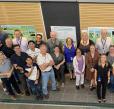Blueprint for future drugs
Structure of protein involved in immune response pair revealed.

Showing 1941 - 1960 of 2566 results
Structure of protein involved in immune response pair revealed.

Applications, Recent results, publications.
ANSTO has been granted a patent in Australia and a number of European countries for the separation, a key radioactive contaminant in critical minerals processing, actinium-227, from process liquors used in minerals extraction.

Recent news, highlights, and impact case studies from CAS’ research and industry user communities and collaborations/partners
An international team led by ANSTO has been awarded a prestigious program grant from the Foundation for Australia-Japan Studies.
The Australian led regional cancer care project in medical physics held its first regional training course in Malaysia to progress Rays of Hope.
A new radiocarbon dating facility opened at the University of New South Wales (UNSW) will complement the extensive radiocarbon facilities at ANSTO’s world-leading Centre for Accelerator Science
ANSTO scientists share approach on the global stage at the IAEA General Conference.
Dr Luiz Bortolan Neto, a structural materials engineer at ANSTO has received an Industry Partnership award for his significant contribution to defence science at the DMTC annual conference in Canberra, last week.

Australia part of global renaissance in fusion power research symbolised by ITER experiment
Highlighting the contribution of four inspirational ANSTO leaders on International Women's Day.
Ultra-flexible electronics has many potential applications within areas such as for example the military, healthcare and energy.
There have been significant developments in small modular reactor technologies in 2022. The International Atomic Energy Agency expects small modular reactors (SMRs) to make an important contribution to achieving global climate goals and energy supply security. But with more than 70 SMR designs under development in 18 countries – including innovative reactors that are yet to be licensed and novel methods of modular manufacturing that are new to the nuclear industry – widely deploying SMRs in time remains a tall task.